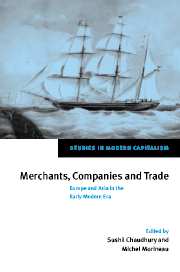Book contents
- Frontmatter
- Contents
- List of contributors
- Preface
- Introduction
- Part I Asia, especially India, around 1500
- Part II Routes, markets and merchants
- 3 The route through Quandahar: the significance of the overland trade from India to the West in the seventeenth century
- 4 The Armenian merchant network: overall autonomy and local integration
- 5 Commercial relations between India and the Ottoman Empire (late fifteenth to late eighteenth centuries): a few notes and hypotheses
- 6 Eastern and Western merchants from the sixteenth to the eighteenth centuries
- 7 The other ‘species’ world: speciation of commodities and moneys, and the knowledge-base of commerce, 1500–1900
- Part III European presence in Asia
- Part IV Implications of trade: Asia and Europe
- Index
5 - Commercial relations between India and the Ottoman Empire (late fifteenth to late eighteenth centuries): a few notes and hypotheses
Published online by Cambridge University Press: 02 December 2009
- Frontmatter
- Contents
- List of contributors
- Preface
- Introduction
- Part I Asia, especially India, around 1500
- Part II Routes, markets and merchants
- 3 The route through Quandahar: the significance of the overland trade from India to the West in the seventeenth century
- 4 The Armenian merchant network: overall autonomy and local integration
- 5 Commercial relations between India and the Ottoman Empire (late fifteenth to late eighteenth centuries): a few notes and hypotheses
- 6 Eastern and Western merchants from the sixteenth to the eighteenth centuries
- 7 The other ‘species’ world: speciation of commodities and moneys, and the knowledge-base of commerce, 1500–1900
- Part III European presence in Asia
- Part IV Implications of trade: Asia and Europe
- Index
Summary
Commercial relations between India and the Ottoman Empire go back to before the establishment of the Mughal Empire and the Ottoman seizure of the Middle East and its borders with India: the states of Sultan Mehmed II emerged as an outlet for Indian textiles at least from the end of the fifteenth century, according to documents from Bursa that are among the oldest Ottoman economic sources. Not only did the Bahmani sovereign of north Deccan, Shah Mohammed III Lashkari (1463–82), exchange ambassadors with Mehmed the Conqueror, but his vizir, Ḫoğa Maḥmūd Gawan (1405-81), sent representatives to trade with the Turks: two of them, Ḫoğa 'Ali and 'Abd ül-'Azīz, were mentioned in 1476. When the latter arrived at Bursa, the former went off to the Sultan's European possessions, leaving him with 877 pieces of fabric given to him by the vizir to sell. From 1479 we have a second reference: in that year the Bahmani vizir entrusted to four persons ‘all kinds of fabrics and other merchandise’ to sell in the ‘country of Rūm’, the name for the Ottoman territories. These merchants had gone through Arabia: one had died on the way, while another died at Bursa. Finally, from 1481 we have a third reference: to a trade mission sent by the vizir to Bursa. Its members appear as his employees and one of them seems to be the leader, with the title of re'īs.
- Type
- Chapter
- Information
- Merchants, Companies and TradeEurope and Asia in the Early Modern Era, pp. 95 - 115Publisher: Cambridge University PressPrint publication year: 1999
- 3
- Cited by



